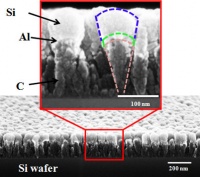The new material, dubbed a ’nanoscoop’ because its shape resembles a cone with a scoop of ice cream on top, can withstand extremely high rates of charge and discharge that would cause conventional electrodes used in today’s Li-ion batteries to rapidly deteriorate and fail. The nanoscoop’s success lies in its unique material composition, structure, and size.
The Rensselaer research team, led by Prof Nikhil Koratkar in the Department of Mechanical, Aerospace, and Nuclear Engineering, has demonstrated how the nanoscoop electrode could be charged and discharged at a rate 40 to 60 times faster than conventional battery anodes, while maintaining a comparable energy density.
This performance, which was achieved over 100 continuous charge/discharge cycles, has the team confident that its new technology holds significant potential for the design and realisation of high-power, high-capacity Li-ion rechargeable batteries.
Batteries for all-electric vehicles must deliver high power densities in addition to high energy densities, Koratkar said. These vehicles today use supercapacitors to perform power-intensive functions, such as starting the vehicle and rapid acceleration, in conjunction with conventional batteries that deliver high energy density for normal cruise driving and other operations. Koratkar said the invention of nanoscoops may enable these two separate systems to be combined into a single, more efficient battery unit.
The anode structure of a Li-ion battery physically grows and shrinks as the battery charges or discharges. When charging, the addition of Li ions increases the volume of the anode, while discharging has the opposite effect. These volume changes result in a build-up of stress in the anode. Too great a stress that builds up too quickly, as in the case of a battery charging or discharging at high speeds, can cause the battery to fail prematurely. This is why most batteries in today’s portable electronic devices, such as mobile phones and laptops, charge very slowly — the slow charge rate is intentional and designed to protect the battery from stress-induced damage.
The Rensselaer team’s nanoscoop, however, was engineered to withstand this build-up of stress. Made from a carbon (C) nanorod base topped with a thin layer of nanoscale aluminium (Al) and a ’scoop’ of nanoscale silicon (Si), the structures are able to quickly accept and discharge Li ions at extremely fast rates without sustaining significant damage.
The segmented structure of the nanoscoop allows the strain to be gradually transferred from the C base to the Al layer, and finally to the Si scoop. This natural strain gradation provides for a less abrupt transition in stress across the material interfaces, leading to improved structural integrity of the electrode.
The nanoscale size of the scoop is also vital since nanostructures are less prone to cracking than bulk materials, according to Koratkar.
’Due to their nanoscale size, our nanoscoops can soak and release Li at high rates far more effectively than the macroscale anodes used in today’s Li-ion batteries,’ he said. ’This means our nanoscoop may be the solution to a critical problem facing auto companies and other battery manufacturers — how can you increase the power density of a battery while still keeping the energy density high?’
A limitation of the nanoscoop architecture is the relatively low total mass of the electrode, Koratkar said. To solve this, the team’s next steps are to try growing longer scoops with greater mass, or develop a method for stacking layers of nanoscoops on top of each other. Another possibility the team is exploring includes growing the nanoscoops on large flexible substrates that can be rolled or shaped to fit along the contours or chassis of the automobile.

Researchers at Rensselaer Polytechnic Institute have developed a new type of nanomaterial that could enable the next generation of high-power rechargeable lithium-ion (Li-ion) batteries for electric automobiles, laptop computers, mobile phones, and other devices




Swiss geoengineering start-up targets methane removal
No mention whatsoever about the effect of increased methane levels/iron chloride in the ocean on the pH and chemical properties of the ocean - are we...